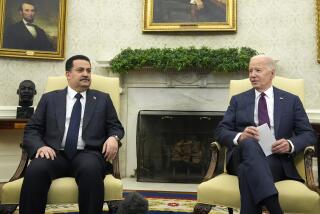EYE ON IRAQ
- Share via
Seven years after the Gulf War, the United States is on the verge of another massive military action against Saddam Hussein. A look at the issues and the military buildup in the region:
ECONOMIC SANCTIONS
Within days of Iraq’s occupation of Kuwait in 1990, the U.N. Security Council imposed strict economic sanctions on Iraq, most prominently an embargo on oil sales. After a U.S.-led military coalition drove the Iraqis out of Kuwait in the 1991 Persian Gulf War, the sanctions remained in place pending Iraq’s compliance with provisions of the cease-fire, including destruction of its nuclear, biological and chemical warfare capacity and its long-range missiles. Responding to privation the sanctions caused among the Iraqi people, the Security Council and the Iraqi government agreed to a program permitting Iraq to sell limited amounts of oil under U.N. supervision for food and medicine. That program now totals $2 billion every six months. U.N. Secretary-General Kofi Annan has proposed increasing that to $5.2 billion.
THE U.N. INSPECTORS
The Security Council set up the U.N. Special Commission on Iraq, or UNSCOM, to monitor the elimination of Baghdad’s weapons of mass destruction. The Iraqi government has never fully cooperated, however, playing hide-and-seek with the commission’s inspectors. As a result, UNSCOM has not certified that Iraq is in compliance with any of the weapons provisions of the cease-fire.
IMPASSE
Iraq’s relationship with the inspectors has deteriorated in recent months as officials in Baghdad have placed large government installations, including presidential compounds, off-limits to investigators. UNSCOM believes that these facilities may house biological and chemical weapons or records of illegal arms research. Iraq contends that it has no such weapons and complains that UNSCOM is a pawn of the United States and will never permit the lifting of sanctions while Iraqi President Saddam Hussein remains in power.
ADMONITIONS
The 15-member U.N. Security Council repeatedly has adopted unanimous statements criticizing Iraq’s defiance of the inspectors. But Russia, China and, to a lesser degree, France have argued for continued diplomacy and against the use of force. Russia and France may be influenced by their desire to resume business with Iraq.
ARGUMENTS AGAINST MILITARY ACTION
Critics of the military option say it would have little effect on the long-term situation in Iraq. Air strikes alone are unlikely to remove Hussein from power, while civilian casualties might increase support for him at home and in the rest of the Arab world. Because chemical and biological weapons are easy to hide and relatively easy to manufacture, the bombing campaign contemplated by the U.S. would not eliminate Iraq’s illegal arms.
ARGUMENTS FOR MILITARY ACTION
The United States says the weapons inspection program has been rendered ineffective by Iraqi intransigence, and supporters of an attack believe that it might pummel Hussein into cooperating. They also argue that Hussein must be shown that there are consequences to defying the Security Council. Although air power alone cannot destroy all of Iraq’s proscribed arms, it can inflict considerable damage to the arsenal and to other props of Hussein’s regime, including Republican Guard military units and his intelligence apparatus.
U.S. PRESENCE IN THE REGION
DEPLOYMENT
Current: 30,000 (est.)
In Gulf War: 500,000
****
IRAQ’s FIREPOWER
Defense analysts say Iraq is still highly vulnerable, with an aging air defense and no navy:
Active armed forces: 350,000
Reserves: 650,000
Battle tanks: 2,000
Aircraft: 300-350 (as few as 100 may be serviceable)
****
PERSIAN GULF
3 aircraft carriers
15 other ships
150 combat aircraft
20,000 sailors and Marines
****
MEDITERRANEAN
4 ships
20 combat aircraft
****
KUWAIT
1,500 Army troops
6 fighter planes
****
BAHRAIN
24 fighter planes
2 bombers
****
SAUDI ARABIA
100 aircraft
****
THE BUILDUP
NAVY
Last fall: 2,300
Current: 20,000
*
AIR FORCE
Last fall: 6,000
Current: 7,400
Some key U.S.-Iraq confrontations since the 1991 Gulf War:
1992
Aug. 2
* “No-fly” zone imposed over southern Iraq
* Americans and allies begin air patrols
Dec. 28
* U.S. plane shoots down Iraqi MiG-25 violating “no-fly” zone
1993
Jan. 7
* Baghdad refuses to remove missiles in southern Iraq
* Allies attack missile sites in Baghdad
June 27
* Americans fire cruise missiles at intelligence headquarters in Baghdad in retaliation for Iraqi plot to assassinate former President Bush. Eight Iraqis die
1994
Oct. 7
* Iraqi troops move toward Kuwait
* Iraqis pull back when U.S. sends carrier group
1996
Aug. 31
* Iraqi forces capture, Irbil, key city in Kurdish area produced by allies
Sept. 3-4
* U.S. retaliates by firing cruise missiles at Iraqi antimissile sites
* President Clinton broadens southern “no-fly” zone to suburbs of Baghdad
Note: Numbers of military troops and equipment are approximate
Researched by CRAIG TURNER and EDITH STANLEY /Los Angeles Times
Sources: Jane’s World Armies, The Military Balance, Times staff and wire reports
More on Iraq, A1, A8
More to Read
Sign up for Essential California
The most important California stories and recommendations in your inbox every morning.
You may occasionally receive promotional content from the Los Angeles Times.












